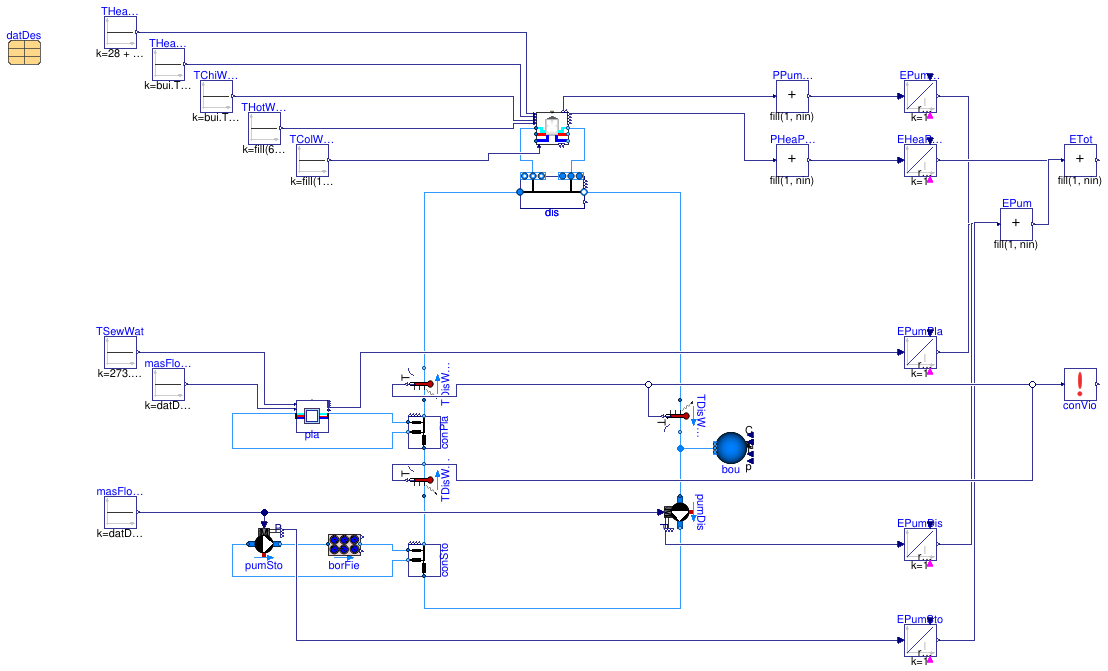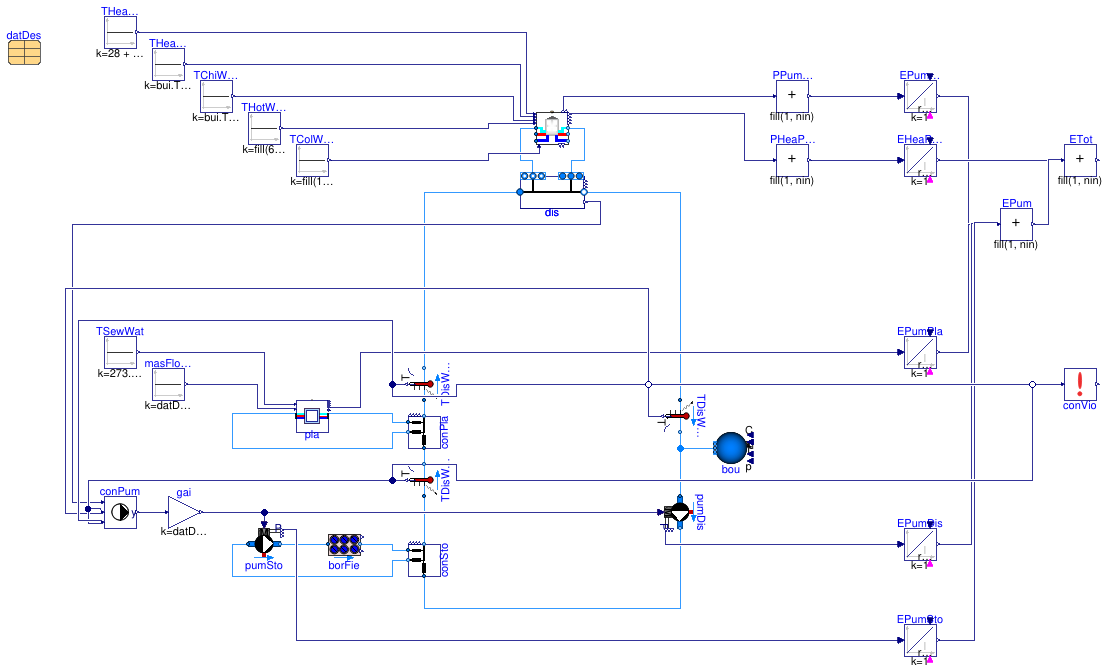Buildings.Experimental.DHC.Examples.Combined
Package of example models for DHC systems
Information
This package contains example models for district heating and cooling systems.
Extends from Modelica.Icons.VariantsPackage (Icon for package containing variants).
Package Content
| Name | Description |
|---|---|
| Example of series connection with constant district water mass flow rate | |
| Example of series connection with variable district water mass flow rate | |
| Package with base classes that are used by multiple models |
 Buildings.Experimental.DHC.Examples.Combined.SeriesConstantFlow
Buildings.Experimental.DHC.Examples.Combined.SeriesConstantFlow
Example of series connection with constant district water mass flow rate

Information
This is a model of a so-called "reservoir network" (Sommer 2020), i.e., a fifth
generation district system with unidirectional mass flow rate in the
district loop, and energy transfer stations connected in series.
In this model, the temperature of the district loop is stabilized through
the operation of the plant and the borefield.
The main circulation pump has a constant mass flow rate.
Each substation takes water from the main district loop and feeds its return water back
into the main district loop downstream from the intake.
The pipes of the main loop are designed for a pressure drop of
dpDis_length_nominal=250 Pa/m at the design flow rate.
References
Sommer T., Sulzer M., Wetter M., Sotnikov A., Mennel S., Stettler C. The reservoir network: A new network topology for district heating and cooling. Energy, Volume 199, 15 May 2020, 117418.
Extends from Buildings.Experimental.DHC.Examples.Combined.BaseClasses.PartialSeries (Partial model for series network).
Parameters
| Type | Name | Default | Description |
|---|---|---|---|
| Real | dpDis_length_nominal | 250 | Pressure drop per pipe length at nominal flow rate - Distribution line [Pa/m] |
| Real | dpCon_length_nominal | 250 | Pressure drop per pipe length at nominal flow rate - Connection line [Pa/m] |
| Integer | nBui | datDes.nBui | Number of buildings connected to DHC system |
| String | filNam[nBui] | {"modelica://Buildings/Resou... | Library paths of the files with thermal loads as time series |
| Assumptions | |||
| Boolean | allowFlowReversalSer | true | Set to true to allow flow reversal in the service lines |
| Boolean | allowFlowReversalBui | false | Set to true to allow flow reversal for in-building systems |
Modelica definition
 Buildings.Experimental.DHC.Examples.Combined.SeriesVariableFlow
Buildings.Experimental.DHC.Examples.Combined.SeriesVariableFlow
Example of series connection with variable district water mass flow rate

Information
This model is identical to Buildings.Experimental.DHC.Examples.Combined.SeriesConstantFlow except for the pipe diameter and the control of the main circulation pump. Rather than having a constant mass flow rate, the mass flow rate is varied based on the mixing temperatures after each agent. If these mixing temperatures are sufficiently far away from the minimum or maximum allowed loop temperature, then the mass flow rate is reduced to save pump energy.
Extends from Buildings.Experimental.DHC.Examples.Combined.BaseClasses.PartialSeries (Partial model for series network).
Parameters
| Type | Name | Default | Description |
|---|---|---|---|
| Real | dpDis_length_nominal | 250 | Pressure drop per pipe length at nominal flow rate - Distribution line [Pa/m] |
| Real | dpCon_length_nominal | 250 | Pressure drop per pipe length at nominal flow rate - Connection line [Pa/m] |
| Integer | nBui | datDes.nBui | Number of buildings connected to DHC system |
| String | filNam[nBui] | {"modelica://Buildings/Resou... | Library paths of the files with thermal loads as time series |
| Assumptions | |||
| Boolean | allowFlowReversalSer | true | Set to true to allow flow reversal in the service lines |
| Boolean | allowFlowReversalBui | false | Set to true to allow flow reversal for in-building systems |
